Living by a lake usually offers peaceful, picturesque views of clear, clean water. However, the beauty and tranquility can quickly diminish when issues like algae blooms, murky ponds, and excessive plant growth arise. Factors such as excess nutrients from soil particles, grass clippings, and warm water conditions can foster the rapid growth of filamentous algae and blue-green algae, turning sparkling waters into brown, muddy, and cloudy environments. These conditions degrade the visual appeal and create significant water quality issues, impacting everything from swimming and boating to the overall environment for fish.

For lake owners, understanding the dynamic interplay of additional nutrients, organic muck, and water movement is critical to maintaining a balanced ecosystem. This discussion delves into why managing lake weeds and algae is essential to preserve water clarity and ensure the health of the aquatic environment. You'll learn about the importance of preventative measures and effective removal techniques that can help maintain normal levels of clarity and prevent problems such as poor water clarity and the presence of dead fish.
As we explore the challenges of maintaining bodies of water, from small ponds to large lakes, you will discover strategic measures to control the green color of algae, deal with slimy material on the water's surface, and tackle clarity issues exacerbated by heat waves and bunches of plants. By effectively controlling and preventing weed overgrowth, you can ensure your lake remains a stunning, pristine environment that continues to provide joy and recreation for all who visit.
Road Map:
-
What Are Lake Weeds and Why Do They Grow?
-
How Do Lake Weeds Turn Clear Water Murky?
-
What Impact Do Murky Waters Have on Lake Ecology?
-
Can Removing Lake Weeds Improve Water Quality?
-
What Are the Common Types of Lake Weeds in Canadian Lakes?
-
Conclusion
-
Frequently Asked Questions
What Are Lake Weeds and Why Do They Grow?
Lake weeds, thriving in bodies of water such as lakes, ponds, and rivers, play a vital role by producing oxygen and providing habitats for fish and other aquatic life. However, when additional nutrients from lawn fertilizers, sewage, agricultural runoff, and grass clippings accumulate in these waters, they can prompt excessive plant growth. This phenomenon, known as eutrophication, can lead to murky ponds, brown water, and cloudy water—typical signs of poor water clarity.

As lake weeds increase, they can obstruct water movement, leading to stagnant zones where filamentous and blue-green algae bloom, further exacerbating water quality issues. The dense mats of plants can cause water to retain more heat, intensifying the problem during heat waves. This rapid growth can also deposit organic muck and slimy material, disturbing the balanced ecosystem and creating murky lakes that are less navigable.
Algae and excessive weed growth can reduce oxygen levels in the water, particularly at night, stressing fish and even leading to dead fish. For lake owners, managing these conditions is critical. Implementing preventative measures ensures that the water maintains normal clarity levels and remains a clean and healthy environment for fish and other aquatic life. Effective management addresses clarity issues and supports the marine ecosystem's overall health, enhancing recreational activities for all users.
How Do Lake Weeds Turn Clear Water Murky?
Murky water is water that looks cloudy or dirty because it has tiny particles like mud, plant bits, or tiny organisms floating in it. This can happen from things like rain washing soil into the water or too many plants growing and decaying in the water. Murky water can make it hard for sunlight to get through and can disrupt life in the water.
Lake weeds can obscure the clarity of water in several ways, impacting visual appeal and ecological balance. As these plants increase in the body of water, they consume space and begin to decompose, which uses up oxygen and decreases water quality.
This growth can also cause lake weeds to trap sediment and other particles suspended in the water, contributing to cloudy water and reduced transparency. The scattered light from this suspended sediment results in murky, less visible water.
Moreover, when an excessive growth of lake weeds occurs, they often die off, particularly following treatment interventions or natural seasonal diebacks. The decomposition of these plants exacerbates water murkiness, as the breaking down of organic matter releases additional particles into the water.
Managing lake weeds is, therefore, essential for preserving the lake's visual clarity and ecological health. Effective management helps prevent the harmful effects of excess plant growth, ensuring the water remains clean and supportive of a balanced aquatic ecosystem.
What Impact Do Murky Waters Have on Lake Ecology?
Murky waters can severely impact the ecology of a lake, creating multiple challenges:
Sunlight Blockage: In murky bodies of water, reduced sunlight penetration affects aquatic plant growth. Essential for photosynthesis, sunlight helps these plants produce oxygen and food. Insufficient light leads to stunted growth, diminishing oxygen levels crucial for fish and other aquatic life.
Temperature Changes: Murky waters, whether in ponds or larger lakes, often heat up more quickly than clear waters. Particles suspended in the water, such as soil particles and organic muck, absorb heat, leading to temperature increases. These changes can be even more pronounced during heat waves, potentially pushing the water's temperature beyond normal levels, which can be detrimental to native species adapted to cooler conditions.
Habitat Disruption: Cloudy or brown water complicates life for aquatic animals, who rely on clear water to spot food and avoid predators. The presence of algae blooms, including filamentous and blue-green algae, contributes to this turbidity, making it difficult for fish to navigate and find food, thus disrupting the aquatic food chain.
Oxygen Levels: Murky water, compounded by excess nutrients from sources like grass clippings and additional nutrients, can lead to excessive plant and algae growth. When these die off, they decompose, consuming oxygen and creating dead zones—areas devoid of life due to low oxygen levels.
Preventative Measures: For lake owners, managing water quality is crucial. Preventative measures can include controlling runoff that carries excess nutrients and installing barriers to catch debris before it enters the water. Maintaining clean, clear water supports a balanced ecosystem and prevents the numerous problems associated with murky, muddy, or cloudy waters.
In summary, maintaining the clarity and quality of water in lakes is essential for preserving a healthy environment for all aquatic life, ensuring that ecosystems remain balanced and vibrant despite environmental challenges.
Can Removing Lake Weeds Improve Water Quality?
Yes, removing lake weeds can greatly enhance water quality in several important ways:

In conclusion, controlling lake weeds is key to maintaining a clean, healthy body of water that supports a thriving and diverse range of aquatic life, benefiting both the environment and recreational activities.
What Are the Common Types of Lake Weeds in Canadian Lakes?
In Canadian lakes, several common types of lake weeds can be found, each with distinct characteristics and growth patterns:



Eurasian Watermilfoil: This invasive weed is notorious for forming dense underwater forests, often leading to water quality issues such as poor water clarity. Its feathery, divided leaves can grow in bunches so thick that they choke out other plants, block boat propellers, and make swimming difficult. This overgrowth can turn clear waters into murky lakes, creating significant challenges for owners.
Curly-leaf Pondweed: Recognizable by its curly, crisp-like leaves, this plant typically emerges early in the spring before other plant growth begins. However, it dies off mid-summer, and its decomposition can cause organic muck buildup and sudden decreases in oxygen levels, contributing to murky waters and potentially dead fish due to low-oxygen environments.
Elodea (Waterweed): A native plant with dark green, whorled leaves, Elodea is generally beneficial in moderate amounts. It provides a habitat for fish and helps oxygenate the water, promoting a balanced ecosystem. However, growing excessively can lead to water quality issues, including cloudy water and reduced water movement.
Duckweed: This tiny, free-floating plant often covers the surface of ponds or lakes like a green carpet. While it may seem harmless, Duckweed can multiply rapidly, blocking sunlight from penetrating the water. This hampers the growth of submerged plants, resulting in brown water and an overall decline in water quality.
Cattails: Commonly found along the edges of lakes, cattails are tall plants with brown, cigar-shaped heads. They are crucial for shoreline stability and provide habitats for wildlife. However, when they grow unchecked, cattails can impede water flow and spread across large areas, disrupting the natural water movement and contributing to poor water clarity.
While these lake weeds can offer benefits, such as providing habitats and contributing to a balanced ecosystem, they can also become nuisances if not correctly managed. Controlling their growth is essential to maintaining clean water, preventing algae blooms, and ensuring the lake's or pond's overall health.
Conclusion
In conclusion, proactively managing lake weeds is vital for maintaining Canadian lakes' clarity, water quality, and beauty. While these aquatic plants play an essential role in the ecosystem, they can quickly become problematic, leading to issues like brown water, algae blooms, and disrupted habitats when they overgrow.

Understanding the common types of lake weeds, such as Eurasian Watermilfoil and Duckweed, and implementing effective management strategies are key steps lakefront property owners can take to keep our lakes vibrant and healthy.
By controlling the spread of these weeds, lake owners can prevent murky waters, poor water clarity, and other water quality issues. This not only preserves the visual appeal of our bodies of water but also ensures that everyone can continue to enjoy our lakes' natural beauty and recreational opportunities for years to come. Maintaining a balanced ecosystem through proactive lake weed management is crucial to these cherished aquatic environments' long-term health and enjoyment.
FAQ: Managing Lake Weeds for Clearer Canadian Waters
1. What are lake weeds and why do they grow?
- Lake weeds are aquatic plants that thrive in water environments. They grow due to nutrient-rich conditions often caused by runoff from nearby land. While essential to the ecosystem, excessive growth can disrupt lake health.
2. How do lake weeds make the water murky?
- Lake weeds contribute to murky water by decaying, which releases particles into the water. They also trap sediments and block sunlight, further reducing water clarity.
3. What impact do murky waters have on lake ecology?
- Murky waters decrease sunlight penetration, affect water temperature, and reduce oxygen levels, all of which can disrupt the habitat and survival of aquatic life.
4. Can removing lake weeds improve water quality?
- Removing lake weeds can significantly improve water clarity, increase oxygen levels, reduce nutrient concentrations, and restore natural water flow, all of which contribute to better water quality.
5. What common types of lake weeds are found in Canadian lakes?
- Common types include Eurasian watermilfoil, curly-leaf pondweed, elodea, duckweed, and cattails. Each has unique characteristics and can impact lake ecosystems differently.
6. Why is proactive lake weed management important?
- Being proactive helps maintain the balance of the lake’s ecosystem, ensuring that the water stays clear and the aquatic environment remains healthy for recreational activities and wildlife.


